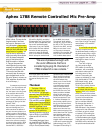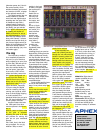
unable, in the heat
of battle, to bypass
the console pre’s.
The Allen &
Heath GL4 we
were using at
FOH uses 1/4
inch ins for its
line inputs, and
we didn’t have
24
XLR-to-1/4-inch
adapters. (Given
our results, it is
hard to believe
that had we
actu ally gone
line-in, it might
have sounded
even better.)
The monitor
console was
a road-worn
Soundcraft Series
800B, and for
What it is: Eight-channel
remote controlled mic pre
Who it’s for:
System owners
with high sonic
requirements and
deep pockets
Pros: Stunning sound.
Relatively easy to use.
Makes recording gigs a
snap
Cons: Very expensive
How much: SRP $4,995 per
eight channels plus $995 for
the A/D and $1495 for the
hardware remote, PC software
free
The Gig
Aphex Systems
11068 Randall Street
Sun Valley, CA 91652
ph: 818-767-2929
fax: 818-767-2641
www.aphex.com
recording the gig we used an
Alesis HD24, running from the
1788’s LightPipe out directly
into the recorder. We ran into
a small problem when we
could not get one of the 1788s
(we were using three units)
to send data to the recorder.
After spending some time
trying to fi gure out why and
confi rming that the other two
units were sending good signal
to the recorder, we opted to
record from two units only
with everything except vocals
and keys, which could be
over dubbed later.
I was at MON and Paul was
at FOH as the band hit the
stage. In very short order, Paul
came
over to me at monitor world
to tell me how amazing his
system sounded. After I
was sure all the mixes were
together and the
band was happy, I stepped
out to Front of House and
was noth ing short of stunned.
I have mixed on this system
before, and Paul has put
together a very nice sounding
rig. It may not be shiny and
new, but it is very well tuned
(courtesy of Showco’s Howard
Page) and well maintained,
and generally sounds very
good. But with the addition
of the 1788s, it sounded like
a totally different and much
better system. Open and clear,
with the kind of air the kind of
air that we all strive for and
The ideal set-up method
is to completely bypass the
mic pre’s on your console-a
sticky subject to be sure. Mics
go from the 1788 and split to
FOH and MON, where they
enter the console-ideally-via
the line inputs. Input gain
is set on the 1788. Here is
where the limiter comes into
play. Aphex has fi gured out
a way to put the limiter
in
front
of the mic pre, which
allows you to run your inputs
signifi cantly hotter than you
might otherwise, especially
if you are using the digital
outs for recording. No more
running your inputs at 1OdB
down to avoid digital clip ping
on loud transients.The
patented limiter lets you get a
big, full signal without having
to worry about overload.
Another feature that sets
the 1788 apart from other
remote systems is that there
are no
glitches, pops or zipper noise
as the gain is adjusted.
Adjusting the gain is as easy
and painless as turning the
gain pot on your traditional
preamp.
Like I said, that is the ideal
set-up method. For our gig
withthe 1788s, we were
(phantom power, etc.) Next is
the control section, which
switches between local control
and remote via MIDI, a laptop
or the optional remote unit.
The Digital section lets you
choose internal or external
word clock and digital output
sampling rate.You get a built-
in headphone amp with a
volume control a button for
switch ing between channels,
and fi nal ly, you get controls
for the built in test tones (one
at -20dBfs and another at
OdBfs)-a lifesaver for set-up
and troubleshooting. Holding
both test tone buttons down
along with Channel 7 selector
button turns the Gain knob to
turn into an Adjust con trol for
dialing in the brightness of the
LEDs from merely visible to
truly retina-burning (very nice
for outdoor gigs).
mostly fail to achieve.
Drums-especially the
snare and cymbals-punched
through the mix without being
strident. Acoustic guitars lost
that piezo
“
quack” and came
through with the richness you
would expect using a good
condenser mic in a studio.The
fi ddle (it was a coun try band)
was a revelation for Paul, who
mixes this band regu larly and
says that the instru ment’s
built-in pickup often “sounds
like crap.” Again, it sounded
like it was being recorded
with a good mic. Vocals were
particularly good. The band’s
four singers all used stan dard
issue Shure SM58s-a good
mic that we all use all the
time, but hardly the latest
and great est thing out there.
I have become something of
a con denser slut in the past
couple of years and now own
six condens er mics (fi ve AKG
C900s and one Audix VX10).
Paul said he thought the
1788 made the 58s sound
like Neumann U47s. I don’t
know if I’ll go that far, but
they sounded better than my
C900s (which I like a lot) and
at least as good as the VX10.
So how impressed were we?
I called Marvin at Aphex on
Monday after the gig and told
him he was offi cially on my
“shitlist, as I am now spoiled
for life and there is no way my
budget has a rack of 1788s
in it. Paul, on the other hand,
who does this for a living, is
getting ready to upgrade to
a more “rider-able” house
console and move the Allen
& Heath to monitor duties.
He was impressed enough
with the sonic difference that
he is considering buying 24
channels of 1788s instead of
a new con sole. We were, in
short, totally blown away.




